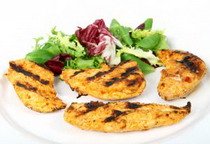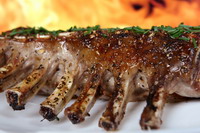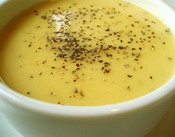Home ›
Making Soup › Homemade Vegetable SoupA
homemade vegetable soup is a wonderful thing. It’s just so much better than anything you’d get in a can. For one thing, only ingredients that
you like end up in the soup. Plus, you have the opportunity to make it much healthier. And, well, making something yourself is just more satisfying.
Making your own homemade vegetable soup is one of the easiest things in the world. And it’s just so versatile. There are a ton of different kinds of vegetable soups — like minestrone, cabbage soup, chicken noodle,beef barley… and so many more.
Vegetable soup is also a great way to empty your fridge before the next trip to the grocery store — you can put almost any vegetable in a good old fashioned vegetable soup.
But if you don’t know how to do it, you can end up with something less than spectacular… it’s not just vegetables boiled in some water and poured in a bowl!
In this article, I’ll go over how to make an awesome homemade vegetable soup. I’ll talk about the different elements that make up a vegetable soup and how they all fit together. Here they are!
The Broth
The broth is one of the most important parts in any homemade vegetable soup. In fact, for the most part, you can think of a vegetable soup as being made up of two parts: the broth, and all the rest of the stuff that goes in the broth.
So what exactly is broth? It’s the liquid part of the soup. If you look up a proper definition, it’s water in which vegetables, meat or fish have been simmered, until they give flavor to the water.
But for this article, I’ll use broth as the liquid part of the soup — it can be much more than just the standard definition of broth! It’s a combination of a whole lot of things: stock, flavoring liquids, and a mirepoix.
Stock
The most important part of the broth is stock. A stock is made from meat and bones simmered in water for a very long time. It can be chicken, beef or fish bones. For a vegetable stock, you just simmer some vegetables in the water.
- You can use any kind of stock in a vegetable soup.
- If you want a vegetarian soup, you’ll have to go with vegetable stock, but chicken, beef and fish stock add a lot more body to a soup. They contain gelatin, which helps the flavors blend better, and has a really nice texture.
- If you’re planning on adding meat to the soup, pick the corresponding stock — so beef stock for a beef and barley soup, chicken stock for chicken noodle, and so on.
- A homemade stock beats a canned stock any day of the week. Find out how to make some by checking out our article on making chicken stock.
Extra Flavors
A homemade vegetable soup broth can also have lots of other flavoring liquids in it. The stock is the main body; the flavoring liquids add a little extra something.
- You can add any kind of liquid to the broth to add flavor. If you think it’ll taste good, try it out! You can always test it in a small amount of stock to see if it’s good.
- Wine can be a nice addition. Just be sure to simmer it a little bit to give the alcohol a chance to boil off.
- Some soups have a tomato base. Just add a bit of tomato juice or even a vegetable juice like V8.
The Aromatic Mirepoix
The last element in a broth is a mirepoix. A mirepoix isn’t anything complicated — it’s just some chopped aromatic vegetables, sauteed in a bit of oil or butter.
- Just dice up some celery, carrots, onion, and maybe a little bit of garlic. Saute for a bit, and you have a mirepoix. The longer you saute, the more intense a flavor it’ll have.
- A mirepoix doesn’t just add flavor to a broth, it also helps enhance the broth’s flavor, and the flavor of your homemade vegetable soup.
- How much should you add? As much as you like. Even a single carrot and celery stalk can add a lot of flavor to a whole pot of soup, but you can easily use more without overwhelming other flavors. Just be sure to have plenty of room in your broth for the other ingredients in your soup.
Making the Broth
The only element I’d say is really necessary is a good stock, even better if it’s homemade. If you have that and you’re short on time, you can skip the rest. You’ll still end up with a great homemade vegetable soup.
Putting the various elements together isn’t hard. Here’s how you do it.
- If desired, chop up some celery, carrots, onion and garlic, and saute them until the onion starts to get soft — this is your mirepoix.
- If you’re adding wine to the soup, add it now. Let it simmer gently until it’s reduced by 1/4 or 1/2.
- Add the stock and other flavoring liquids.
Meat, Poultry or Tofu
Even though it’s a vegetable soup, that doesn’t mean it has to only have vegetables. Some chicken pieces, chunks of beef, or even little squares of tofu can turn a light homemade vegetable soup into a very satisfying and wholesome meal.
So what kind of meat can you add? Just about anything!
Leftovers
Soup is great for leftovers. If you have some leftover meat, you can just toss it into the soup.
- I tend to make my soup from a homemade chicken stock made from the bones of a roasted chicken, so I usually have a few pieces of cooked chicken leftover to add in the soup.
- You can add any kind of meat you like — beef, lamb, etc… just avoid mixing different kinds, because that can taste kind of weird.
Cooking Meat
If you don’t have any leftovers, you can also cook the meat (or tofu) directly in your old-fashioned vegetable soup.
- If you want, you can just cut up the meat into pieces and toss it into the broth. You just have to make sure it simmers long enough to fully cook the meat.
- A better way to do it is to sear the meat before boiling it. It adds flavor, and it looks a lot more appealing.
- Before making the broth, sear the chunks of meat in your soup pot. Take them out, then make your broth, and toss them back in. They can finish cooking while the soup is simmering.
- This is the best way to add ground meat to a homemade vegetable soup.
- If you dredge your chunks of meat in a bit of flour, they’ll sear more evenly, and it’ll thicken the broth a little bit.
Notes
- You can add as much meat (or poultry, or tofu) to your soup as you like. It depends on what you feel like. The more you add, the more filling it’ll be, but then you won’t have as much room for nutrient-packed vegetables.
- It’s best to add small pieces of meat rather than big chunks.
- First of all, you never want to have to cut anything in a soup with a knife and fork. You just need a spoon!
- Second, it’s nice if the pieces are small enough that they’ll fit on a spoon with a few other veggies, too. An old fashioned vegetable soup is all about blending flavors!
Beans, Grains and Pasta
Just like a bit of meat, poultry, or tofu, beans, grains, or pasta can make your homemade vegetable soup a lot more filling. Beans and grains add a whole lot of nutrition, too. And of course, if you’re vegetarian, you can add as much as you like!
Beans, grains and pasta are a little bit trickier than meat though:
 Beans and grains can take a while to cook, especially if you’re starting from dry beans.
Beans and grains can take a while to cook, especially if you’re starting from dry beans.- Beans, grains and pasta absorb some water as they cook, making the soup thicker.
So here are a few tricks to making a great homemade vegetable soup with beans, grains or pasta:
- Try pre-cooking them, then adding them to the soup (discarding the cooking water). This is the simplest way, but for beans and grains it means throwing some nutrients down the drain with that cooking water.
- Start with more broth than you think you need to compensate for whatever will evaporate or be absorbed.
- Keep some extra stock on hand to add to the soup if you feel it gets too thick.
- Canned beans are already cooked/soaked, so they don’t mess up the liquid content of your soup.
Some beans and grains that work great in soup are barley, rice, chick peas, lentils, and quinoa. But you can try it with anything you like.
Vegetables
It wouldn’t be a homemade vegetable soup without some vegetables! But what kind of vegetables should you add? And how many? And how long should they cook?
Well, here are a few simple guidelines to follow when adding vegetables to your homemade vegetable soup.
- You can add any vegetable you like to a vegetable soup. But it’s a good idea to pick vegetables that go well together.
- If you add some bitter vegetables, like broccoli, brussel sprouts, or turnips, try to balance it with sweet vegetables like sweet potato, carrots, or peas, and vice-versa. It’s not necessary though, if you’re going for a “sweet” soup.
- A lot of people don’t like overcooked vegetables. If you want to avoid overcooking vegetables, just figure out how long each vegetable needs to cook to be just right.
- Add the veggies that need to cook longest first, letting them cook a bit before working your way to adding the vegetables that take the least time to cook.
- Personally, I don’t mind overcooked vegetables in a soup one bit. If they’re soft, I’m happy. So if you don’t mind either, don’t be too fussed about cooking the vegetables for the exact amount of time.
- Be sure to cut the vegetables into bite-sized pieces.
- A soup is all about blended flavors. If you use smaller vegetable chunks, you can fit a few different kinds on a spoon and get a better taste experience!
- Smaller vegetable pieces cook faster, too, so it cuts down on your dinner preparation time.
- The only rule to how much to add is that you should have enough broth to cover all your vegetables. Other than that, just do what you feel.
- If you want a lighter soup, just add fewer veggies.
- If you want a soup that’s more of a meal, pack it full of vegetables so that each spoonful is full of veggies.
 You can really add anything you like to a homemade vegetable soup. It’s a great time to empty out the fridge.
You can really add anything you like to a homemade vegetable soup. It’s a great time to empty out the fridge.
Try carrots, cauliflower, broccoli, sweet potato, peas, corn, brussel sprouts, tomatoes (canned or fresh), shredded cabbage, mushrooms, asparagus… anything, really!
You can even be adventurous and try adding some fruit like apple or pineapple.
My dad always added whole garlic cloves to the soup. Simmering for a long time made them pretty mild, and my brother and I always loved getting a whole clove, or an “eyeball” as we called it. And it’s so good for you, especially if you’re coming down with a cold!
Seasonings
The last thing that makes up a homemade vegetable soup is the seasoning you add in, the herbs and spices.
Again, you can add any kind of seasoning you like, but just be sure to pick something that goes well with your vegetables, meat, and grains.
Here are a few tips to adding seasoning:
- The broth in your soup will tend to reduce the longer you cook the soup. That means that any seasoning you add will get more intense as the soup cooks.
- However, some seasonings need time in the soup to really give some flavor, like fresh herbs, bay leaves, or star anise.
There are plenty of seasonings that go great in soup. Try ginger, rosemary, thyme, basil, oregano, cilantro, onion powder, garlic powder, cayenne pepper, cloves or cinnamon.
Really, you can try out any seasoning you like. If you’re not sure it’ll taste good, just try it out in a bit of broth before adding it to the pot.
My dad often adds a pinch of cinnamon to his chicken soup. He makes a thick soup with lots of vegetables like broccoli, cauliflower, carrots, and sweet potatoes, and the cinnamon gives it a special warm autumn meal feel. You never know what’ll be good!
And that’s really all there is to it. You can put as much or as little as you like into your homemade vegetable soup. The real key is to use these basics to experiment and find something that you truly enjoy!





 Buttering the bird. You can rub a little bit of softened butter over and under the skin.
Buttering the bird. You can rub a little bit of softened butter over and under the skin.
 When you cover turkey with a lid, you seal in all the steam and juices. Instead of roasting the turkey, you’re steaming it.
When you cover turkey with a lid, you seal in all the steam and juices. Instead of roasting the turkey, you’re steaming it.
 Remove the turkey from the oven. Cover, and let stand 20-40 minutes before carving.
Remove the turkey from the oven. Cover, and let stand 20-40 minutes before carving.

 Beans and grains can take a while to cook, especially if you’re starting from dry beans.
Beans and grains can take a while to cook, especially if you’re starting from dry beans. You can really add anything you like to a homemade vegetable soup. It’s a great time to empty out the fridge.
You can really add anything you like to a homemade vegetable soup. It’s a great time to empty out the fridge.






